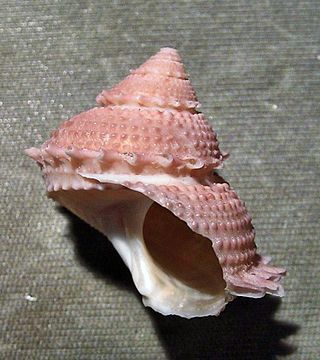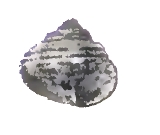
Muricidae is a large and varied taxonomic family of small to large predatory sea snails, marine gastropod mollusks, commonly known as murex snails or rock snails. With over 1,700 living species, the Muricidae represent almost 10% of the Neogastropoda. Additionally, 1,200 fossil species have been recognized. Numerous subfamilies are recognized, although experts disagree about the subfamily divisions and the definitions of the genera. Many muricids have unusual shells which are considered attractive by shell collectors and by interior designers.

The operculum is a corneous or calcareous anatomical structure like a trapdoor that exists in many groups of sea snails and freshwater snails, and also in a few groups of land snails; the structure is found in some marine and freshwater gastropods, and in a minority of terrestrial gastropods, including the families Helicinidae, Cyclophoridae, Aciculidae, Maizaniidae, Pomatiidae, etc.

Turbinidae, the turban snails, are a family of small to large marine gastropod molluscs in the superfamily Trochoidea.

Calliostoma is a genus of small to medium-sized sea snails with gills and an operculum, marine gastropod molluscs within the family Calliostomatidae, the Calliostoma top snails. Previously this genus was placed within the family Trochidae. Calliostoma is the type genus of the family Calliostomatidae.
Stomatellinae is a subfamily of small sea snails with a brilliantly nacreous interior of the shell, marine gastropod mollusks in the family Trochidae, the top snails.

Trochoidea is a superfamily of small to very large vetigastropod sea snails with gills and an operculum. Species within this superfamily have nacre as the inner shell layer. The families within this superfamily include the Trochidae, the top snails. This superfamily is the largest vetigastropodan superfamily, containing more than 2,000 species.

Fossarina is a genus of sea snails, marine gastropod molluscs in the family Trochidae, the top shells.

Modelia granosa, common name the southern cat's eye, is a medium to large species of sea snail which has a shell with a pearly interior and a calcareous operculum. It is a marine gastropod mollusc in the family Turbinidae, the turban snails.

Argyropeza is a genus of small deep-sea sea snails, marine gastropod molluscs in the family Procerithiidae.

The marine snail Norrisia norrisii is a medium-sized gastropod mollusk within the family Tegulidae. It has several common names, including Norris's top snail, Norris's topsnail, norrissnail, smooth brown turban snail, or kelp snail. It was first described by G.B. Sowerby I under the name Trochiscus norrisii.

Lunella smaragda, common name the cat's eye snail, is a species of sea snail, a marine gastropod mollusk in the family Turbinidae, the turban snails.
Isanda is a genus of sea snails, marine gastropod mollusks in the family Trochidae, the top snails.

Uvanilla olivacea, common name the blood-spotted star shell, is a species of sea snail, a marine gastropod mollusk in the family Turbinidae, the turban snails.

Bayerotrochus tangaroanus, or Tangaroan slit shell, is a species of sea snail, a marine gastropod mollusc in the family Pleurotomariidae.

Bayerotrochus teramachii, is a species of sea snail, a marine gastropod mollusc in the family Pleurotomariidae.

Tectus royanus is a species of sea snail, a marine gastropod mollusk in the family Tegulidae.

Astralium lapillus is a species of sea snail, a marine gastropod mollusk in the family Turbinidae, the turban snails.

Bolma bartschii, common name Bartsch's star bolma, is a species of sea snail, a marine gastropod mollusk in the family Turbinidae, the turban snails.

Bolma henica, common name the deep sea star shell, is a species of sea snail, a marine gastropod mollusk in the family Turbinidae, the turban snails.

Monilea incerta is a species of sea snail, a marine gastropod mollusk in the family Trochidae, the top snails.


















